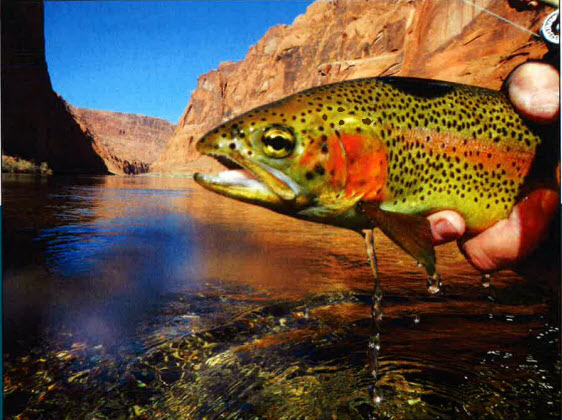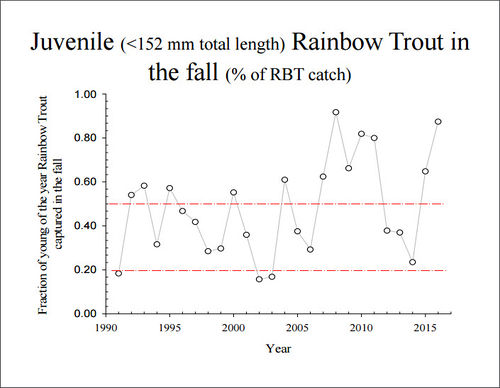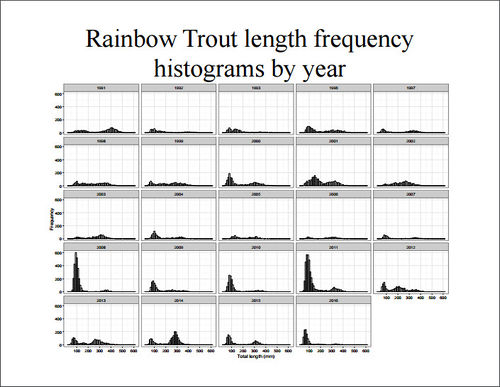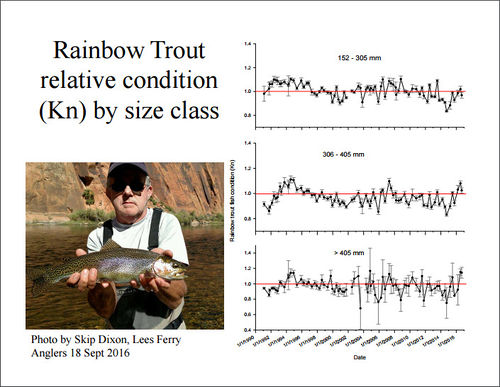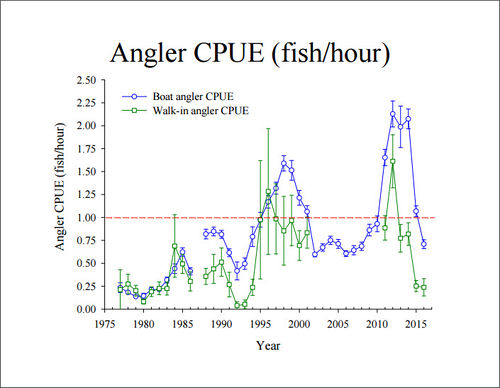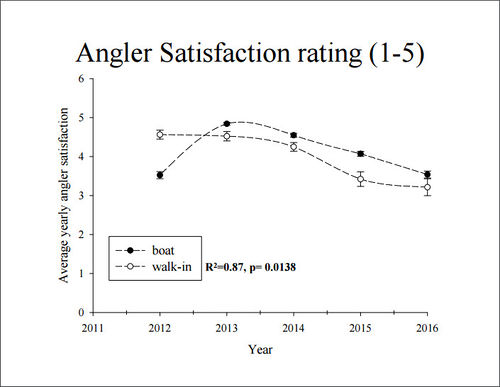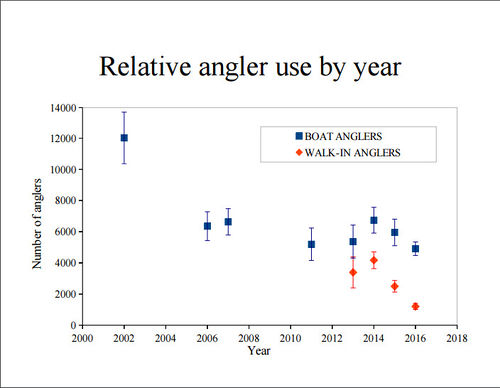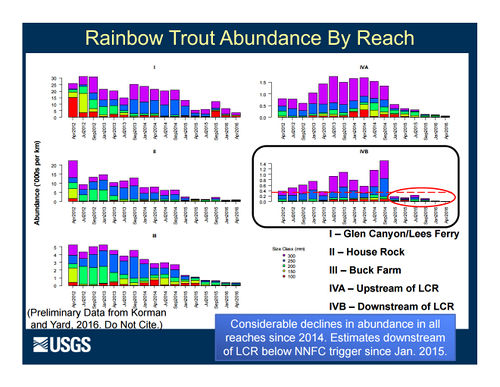Updates
|
|
|
2014 Collapse of the Lees Ferry Rainbow Trout Fishery
|
|
Data from a large-scale mark-recapture study was used in an open population model to determine the cause for long-term trends in growth and abundance of a Rainbow Trout Oncorhynchus mykiss population in the tailwater of Glen Canyon Dam, AZ. Reduced growth affected multiple life stages and processes causing negative feedbacks that regulated the abundance of the population, including: higher mortality of larger fish; lower rates of recruitment (young of year) in years when growth was reduced; and lower rates of sexual maturation the following year. High and steady flows during spring and summer of 2011 resulted in very large recruitment event. The population declined 10-fold by 2016 due a combination of lower recruitment and reduced survival of larger trout. Survival rates for trout ≥ 225 mm in 2014, 2015, and 2016 were 11%, 21%, and 22% lower than average survival rates between 2012 and 2013, respectively. Abundance at the end of the study would have been three- to five-fold higher had survival rates for larger trout remained at the elevated levels estimated for 2012 and 2013. Growth declined between 2012 and 2014 owing to reduced prey availability, which led to very poor fish condition by fall of 2014 (~0.9-0.95). Poor condition in turn resulted in low survival rates of larger fish during fall of 2014 and winter of 2015, which contributed to the population collapse. In Glen Canyon, large recruitment events driven by high flows can lead to increases in the population that cannot be sustained due to limitations in prey supply. In the absence of being able to regulate prey supply, flows which reduce the probability of large recruitment events can be used to avoid boom-and-bust population cycles. Our study demonstrates that mark-recapture is a very informative approach for understanding the dynamics of tailwater trout populations. [2]
|
|
Links and Information
|
|
|
Related Pages
|
|
|
Rainbow Trout Projects
|
|
|
AZGFD Lees Ferry Rainbow Trout Fishery Annual Reports
|
|
|
Presentations and Papers
|
|
2018
2017
2016
- Grand Canyon Monitoring and Research Center Science Updates (BO Compliance, Trout Updates, Green Sunfish, Fisheries PEP, Partners in Science)
- Bair et al. 2016 Economic Value of Angling on the Colorado River at Lees Ferry: Using Secondary Data to Estimate the Influence of Seasonality: North American Journal of Fisheries Management, no. 6, vo. 36, p. 1229-1239,
- Current Status of the Lees Ferry Fishery - Spring 2016
- Lees Ferry Recreational Trout Fishery Management Recommendations: The Voice of Lees Ferry Recreational Anglers, Guides, and Businesses
- Memo from Scott VanderKooi to TWG Chair Dated 12/9/15, Subject: Technical Review of the Lees Ferry Recreational Trout Fishery Management recommendations
- Long-Term Monitoring of the Lees Ferry Fishery: Update
- Economic value of angling on the Colorado River at Lees Ferry: Using secondary data to estimate the influence of seasonality
2015
2014
2013
2012
2011
2010
2009
|
|
|
|
The river is a living creature. Just because you caught fish in a certain spot in years past, don’t think that you are going to experience the same success this year. Fishing is changing daily. It is our goal and desire that everyone have a great trip to the Ferry. Be sure to stop by the shop to see the flies that are currently working. The flies change on a daily basis and every day LFA guides let everyone at the shop know the top producing flies and how to use them. We are anxious to share this knowledge with you – even where to fish!
There is an ongoing aquatic food base study that has taken place over the past couple of years. The purpose of this study is multifaceted and is studying the relationship of flows on food production, taking inventories of and monitoring populations of aquatic insects and invertebrates that live in the river and other very important aspects of the aquatic food base. I believe that this is by far the most important study that has ever been conducted on this river. Previously, hundreds of millions of dollars have been spent studying sediment while ignoring the aquatic food base and resource. Common sense dictates that fish, birds and animals do not live off of dirt or sand. The aquatic food base and habitat are the foundation for all that lives in the Colorado River. One of the long term goals of the food base study is to determine how to enhance the populations and production of aquatic insects in the river which will benefit native fish, trout, and migratory bird populations. This is a study and a goal that we can all embrace!
Quagga mussels have become established in Lake Powell and we are now seeing some in the river below the dam. Their arrival in the river happened sooner than I expected. So far, there has not been a major infestation and there is some thought by experts that they will not become very well established in the river due to the current. Be aware and remember to dry waders and boots before using them in any other body of water. Also, all private boats should drain all water from the boat and live-wells as soon as you exit the river. We all need to do our part to limit the transport of this and all invasive species.
|
|
|
|
In Bishop et al. (1987; on page 410 of the 30 page report: “Grand Canyon Recreation and Glen Canyon Dam Operations: An Economic Evaluation) fluctuating flows are defined as any operation where the daily flow fluctuation was equal to or more than 10,000 cfs/day. Bishop treated daily flow fluctuations of less than 10,000 cfs/day as “constant flow releases.” Bishop identified that this “10,000 cfs threshold was determined to be the point at which fluctuations begin to be perceptible to recreationists.”
Additionally, Stewart et al.’s (2000) follow-up of the Bishop et al. (1987) study found that angler’s did not identify river level fluctuations, at least under the MLFF operating regime, as an issue. Based on information from Stewart et al (2000) and Bishop et al. (1987), any flow fluctuation below 10,000 cfs/day should be treated the same as a steady flow release.
|
Other Stuff
|
|
Nutrients released from GCD and trout competition appear to have a bigger effect on growth than fall HFEs [3]
The interaction of fish, foodbase, and temperature
Fish occupying warmer water have higher metabolic demands than individuals in cooler water, and if these demands increase concurrently with a seasonal decline in prey availability, then growth rates may be reduced. [4]
- Vermillion: Highlights the passion the fishing community has for the Glen Canyon fishery and their love of not only the fishing experience but for the total experience.
|
Visitor Use and Experience
- Visitor Experience as it relates to fisheries, include opportunities to fish for rainbow trout in GCNRA's Glen Canyon Reach, which has been referred to as Blue Ribbon by the State of Arizona, and to fish for rainbow and brown trout and a variety of non-native introduced fish species in the main stem Colorado River and some tributaries in GCNP. Most angling in GCNP occurs in or near Bright Angle Creek and Phantom Ranch, particularly in fall and spring (NPS 2006c).
HISTORY
- In 1991 the Arizona Game and Fish stocked large trout instead of fingerling trout to maintain the Lees Ferry trout sport fishery (090711_Minority Report to TWG_FFF_Mark Steffen)
Additional Links
|
